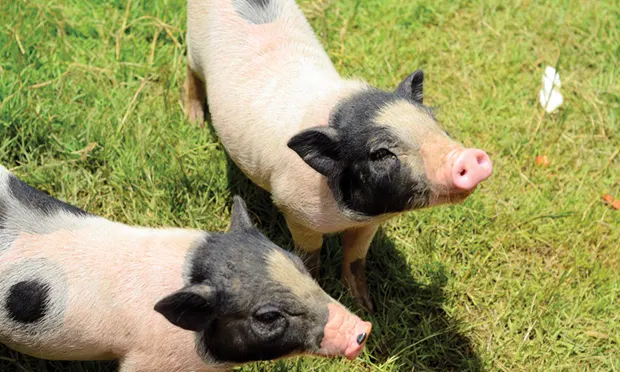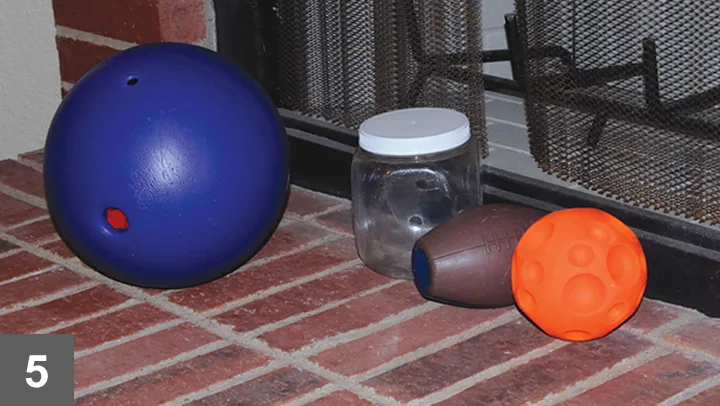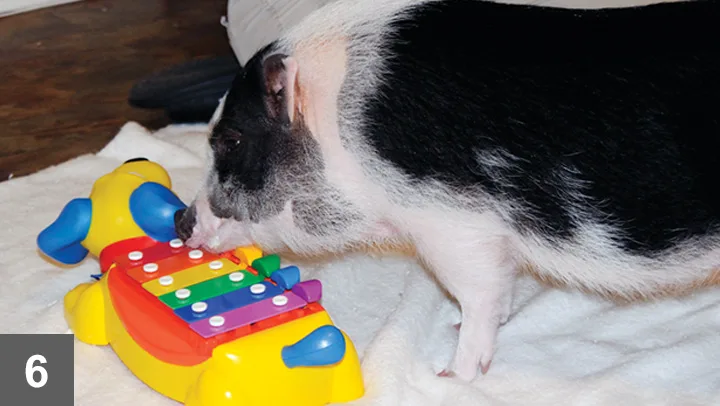Environmental Enrichment for the Miniature Pet Pig

With their flat pink snouts, fat bellies, and round jowls, miniature pigs are appealing and are often purchased on impulse. Pigs, however, are not funny-looking dogs; they have unique behaviors that can make their care and housing a challenge.
Related Article: Ovariohysterectomy in the Teacup Pig
To understand the pig’s environmental needs, it is necessary to be familiar with the time budget of the pig in the wild. Feral pigs spend the majority of their day either foraging for food or resting.1 When foraging, they use their excellent sense of smell to locate food sources and their strong snout to dig into the earth for invertebrates, fungi, roots, and seeds. Pigs eat most anything while foraging, including carrion.2
Pig-Proofing
Although miniature pigs can be housetrained and make good indoor pets, they still require time outdoors. Restricting a pig to living completely indoors is not in the animal’s best interest and makes providing for its physical and mental health needs extremely difficult. Owners who choose to keep a pig indoors much of the time and allow it outdoors primarily for elimination need to be educated that the pig’s indoor area must be carefully “pig-proofed” (Figure 1); otherwise, a pig will use its nose to root up flooring, move furnishings, and sometimes even remove wallpaper and drywall.
When a pig cannot be supervised, it needs to be confined in a room where the owner will not be too distressed if a certain amount of damage occurs. The room should contain a variety of items for the pig to manipulate with its nose, such as old blankets or other bedding; stuffed animals; newspapers; large and heavy, rubber, vinyl, or plastic balls; and pillows (Figure 2). Avoid any toy that is fragile or has small parts that could be broken off and ingested. Most toys that are safe for small children are safe for pigs. Studies show, however, that pigs prefer items that they can manipulate and destroy; otherwise, they quickly tire of them.3 Offering paper that can be shredded and is unlikely to cause harm when eaten is useful for indoor pigs. Ropes made of natural fibers with ends to fray are often provided to pigs housed in commercial or laboratory swine facilities and are good alternative toys for pet pigs.
Foraging
Many owners complain that their pig is “always hungry.” Actually, they are mistaking the pig’s drive to forage for hunger. Even though the pig’s need for food has been met, its motivation to spend time investigating and manipulating its environment has not. This drive is best satisfied by feeding the pig its ration in rooting boxes and by offering foraging toys or puzzles.
A rooting box (Figure 3) can be made of any container with sides low enough for the pig to step into and large enough for the pig to turn around in. Small, plastic wading pools are excellent for this purpose: cut a small entryway to allow the pig to easily step in and out. Fill the bottom of the box with smooth, flat stones, small plastic balls (Figure 4), or loosely crumpled newspaper. Advise the pet owner to sprinkle a portion of the pig’s daily ration in the rooting box and allow it to hunt for the food. Not only does this slow the pig’s eating, giving it more time to feel satiated, but it mimics the time that the pig might spend foraging in the wild. Because the rooting box will smell like food and be associated with food in the pig’s mind, the animal will go there frequently to root. Time spent performing this appropriate, species-typical behavior is time not spent performing destructive behaviors.
Foraging toys (Figure 5) are another enrichment device pigs enjoy. Foraging and puzzle toys available commercially for dogs can also be used for pigs. These devices can also be homemade and created from plastic bottles or jugs by cutting holes of approximately the same size as the pig’s feed in the bottle. Pour feed into the bottle and give to the pig to manipulate with its nose. As the bottle moves, food falls out of the holes.
To provide variety and to keep the pig “thinking,” feeding can be rotated between the rooting box and other foraging puzzles. There is no reason to ever feed a healthy adult pig from a bowl.

Foraging toys and other toys that a pig might enjoy.
Outdoor Pigs
When a pig cannot be supervised, it needs to be confined in a room where the owner will not be too distressed if a certain amount of damage occurs.
Pigs that are housed primarily outdoors will live a more enriched life simply by being outdoors. However, they can still get into trouble and make owners unhappy by damaging a well-groomed yard. Encourage owners to fence off a section of yard in which to confine the pig. A rooting area, which can be a depression filled with sand or soil or even a plastic wading pool, should be provided. Areas of softer soil naturally draw the pig, especially if food is periodically scattered there. Straw and hay are also compelling to most pigs, and they will spend time investigating and rooting in these materials, particularly when first offered.
Pet owners who are less concerned about the beauty of their yards can be advised to spread pig food across the grass; this is an excellent way to make the pig forage for its food. Providing foraging toys and rooting boxes can still help limit damage that a pig will do to a yard.
Related Article: Environmental Enrichment for Small Mammals
Warn owners in hot climates to expect that a pig will dig in an attempt to reach cooler subsoil for resting. Pigs also up-end water containers to make their own mud puddles for cooling. It is important to secure drinking water sources so pigs do not run out of drinking water on a hot day.
Positive Reinforcement Training
Pigs are intelligent animals, and positive reinforcement training stimulates the pig’s mind and reinforces the human–animal bond (Figure 6). Some owners may think that training their pigs to do tricks is somehow demeaning, but positive reinforcement training is an excellent way to enrich a pig’s life. Positive reinforcement training also helps teach the pig to participate in its own health care by learning to allow examination of body parts, venipuncture, weighing, and simply tolerating handling by people. Because pigs are prey animals, humans interacting with them in a consistent, predictable manner helps establish trust.

A child’s toy can be used for enrichment of the pet pig. This toy is only used under supervision as the pig has been taught to play with it to receive a food reward.
Social Enrichment
Pigs are by nature highly social, so housing with conspecifics is one of the most valuable forms of enrichment. Although human companionship is valuable, it is unlikely to provide the equivalent degree of companionship as another pig. Ideally, pigs should never have to live without a conspecific. Pigs do not naturally accept unknown pigs into their family groups, however, and severe aggression is likely when 2 unfamiliar pigs first meet.4 While unfamiliar pigs can be introduced and eventually learn to live together quite peacefully, encourage pet owners to acquire at least 2 pigs at the same time to avoid the trauma of introducing unfamiliar pigs later in life.
In Sum
Pigs make unique and charming pets, but their behavioral needs make them challenging to maintain. Providing appropriate enrichment can make the difference between enjoying the pet pig and perceiving it as a destructive nuisance. Social enrichment is extremely important, but providing a pig with a variety of items to manipulate with its nose is one of the most important forms of enrichment. Training the pet pig with positive reinforcement also provides an effective form of enrichment and helps establish a bond between the pig and owner.
VALARIE V. TYNES, DVM, DACVB, is a veterinary services specialist at Ceva Animal Health, where she provides behavior education, training, and technical support to the sales force and presents lectures and presentations to veterinarians in the field. Her special interests include behavior and welfare of pet pigs, exotic pets, and zoo animals. Dr. Tynes frequently speaks at veterinary meetings around the country and provides consulting services to zoos and veterinarians. She is a graduate of Texas A&M University.